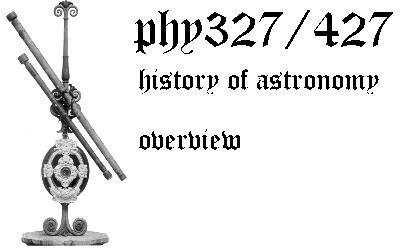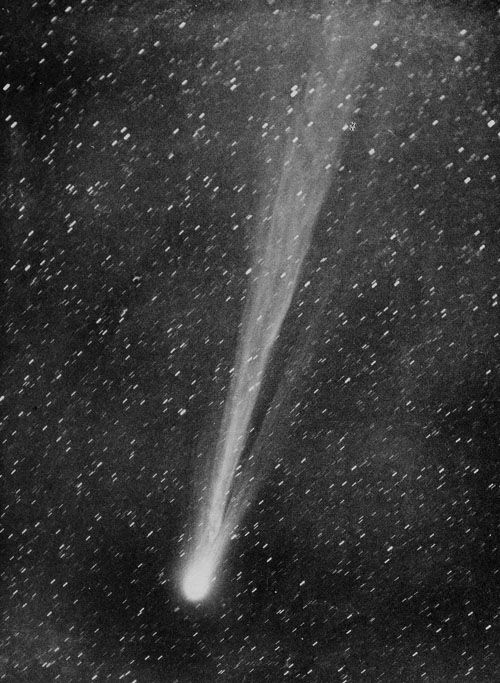Summary
The course aims to provide an introduction to the historical development of
modern astronomy. After a brief chronological overview and a discussion of the
scientific status of astronomy and the philosophy of science in general,
the course is divided into a series of thematic topics addressed in roughly
chronological order. We will focus on the nature of discovery in astronomy,
in particular the interplay between theory and observation, the role of
technological advances, and the relationship between astronomy and physics.
Syllabus
The course is divided into ten themes, two of which are introductory and
the remaining eight approximately chronological.
-
1. Astronomy in History
-
timeline for history of astronomy with useful context from other sciences and history
-
2. Astronomy as Science
-
brief introduction to philosophy of science: empiricism, inductivism,
Popper's falsifiablity criterion, Kuhnian paradigm shifts
-
3. Early Astronomy: Earth and Sky
-
application of astronomical phenomena to calendars, time-keeping, navigation
-
4. Renaissance Astronomy and beyond: the Earth in Space
-
geocentric and heliocentric cosmologies; orbital motion; stellar distances.
Move from descriptive algorithms ("saving the phenomena") to explanatory approach
as per modern science (Ptolemy→Copernicus→Kepler→Newton).
Concept of universal physical laws (contrast Newton with Aristotle).
End of the era of naked-eye observing.
-
5. The Rise of the Telescope: the role of instrumentation in astronomical advance
-
development of telescopes and instrumentation (photography, spectroscopy)
and its effect on astronomical knowledge from Galileo to Hubble;
parallax and the beginnings of the astronomical distance scale;
spectroscopy and the Doppler effect.
-
6. The Astronomical Zoo: objects and classification systems
-
evolution of our concepts of astronomical objects and classification systems
and their effects (e.g. recategorising the Sun as a star;
distinguishing between intragalactic "nebulae" and extragalactic "galaxies";
recognising supernovae as distinct from novae, etc.)
-
7. Astrophysics
-
20th century advances in understanding of "extreme physics":
quantum & atomic physics and stellar energy generation and evolution;
pulsars as neutron stars; black holes
-
8. Beyond the Visible 1: radio astronomy
-
radar and the birth of radio astronomy; challenges of radio astronomy;
impact of radio astronomy on extragalactic astronomy (especially cosmology);
the high redshift universe
-
9. Cosmology
-
impact of general relativity; Hubble law;
Big Bang vs Steady State (case study of hypothesis testing, cf. Topic 2);
Hubble Wars (case study in how not to calculate your systematic errors?);
inflation and the developing linkage between cosmology and particle physics
-
10. Beyond the Visible 2: impact of space exploration on astronomy
-
direct impact of space exploration on planetary physics;
increasing impact of space-borne platforms for extending the usable spectrum
(IR, UV, X-rays) and improving resolution (HST, Hipparcos)
Recommended textbooks
The principal recommended text is
- The Cambridge Concise History of Astronomy, edited by Michael Hoskin
More or less what it says on the can! Covers most of the course,
but weak on more recent "history", e.g. space-based instrumentation.
Also worth consulting are:
- Malcolm Longair, The Cosmic Century
Subtitled A History of Astrophysics and Cosmology, and, as its name
suggests, more or less restricted to the 20th century (as discussed in the
course, both astrophysics and cosmology are 20th-century developments).
Longair is a former Astronomer Royal for Scotland and the author of a number
of textbooks on high-energy astrophysics and galaxy formation. This is very much
as astronomer's view, with much more detail of the actual science (as opposed to
the history) than Hoskin. A good source of references to the primary literature.
- Anton Pannekoek, History of Astronomy
Highly respected textbook, but somewhat dated
(English edition originally published in 1961, Dutch original in 1951).
Very detailed on astronomy in antiquity (Babylonians and Greeks).
- Hugh Thurston, Early Astronomy
Goes into more detail than Hoskin, but more readable than Pannekoek.
Only covers the era of naked-eye astronomy (i.e. stops ~1600).
Useful for Topic 2:
- Alan Chalmers, What is this thing called Science?
- Peter Godfrey-Smith, Theory and Reality:
an introduction to the philosophy of science
Two clear and sensible (by the standards of these things)
introductions to the philosophy of science.
- Gregory Derry, What Science is and How it Works
Rather broader and less technical discussion of the nature of science,
including scientific method, scientific worldview, science vs pseudoscience, etc.
All of these are available in the Information Commons or the Main Library.
Assessment
The assessment for PHY327 has two parts:
- The end-of-semester exam (50%)
- Covers the taught material. The rubric is "Answer any
three questions (out of six)." Obviously, given the nature of the course,
these are descriptive questions, not numerical.
- For example questions with comments and outline answers, see the
lecture notes page.
- A 3000-word essay (10% + 40%)
- Write an essay on a topic in the history of astronomy (choose any one from
a list of about ten). The aim of this exercise is to develop your skills in
retrieving and assimilating information from a variety of written sources, and
in communicating this in a clear, informative, well-structured and properly
referenced form.
- The first 10% of the essay mark is awarded on the basis of an
essay plan, consisting of a detailed table of contents, with notes,
and a list of sources. This should help you to turn in a better essay and
develop your skills in carrying out a literature search.
The assessment for PHY427 has three parts:
- The end-of-semester exam (40%)
- This is the same as the PHY327 exam, but is worth slightly less
because as 4th year students you should be capable of more than
factual recall and synthesis.
- A "News and Views" article (20%)
- Discuss a classic paper in astronomy in the style of a Nature
"News and Views" article. The aim of this exercise is to test your ability to
set a piece of astronomical work in its proper historical context and explain this
successfully to a non-specialist audience. Critical assessment of sources is
part of the benchmark for 4th year courses.
- A 3000-word essay (40%)
- The essay is the same as for PHY327, but as you have already done a literature
search and written at least one project report you don't get marks for the essay
plan – you should already know how to do this. If you want to hand in an
essay plan for feedback, you are very welcome to do so, but you don't get
credit for it. (It may improve your final essay, though!)
More information can be found in the page on coursework.



